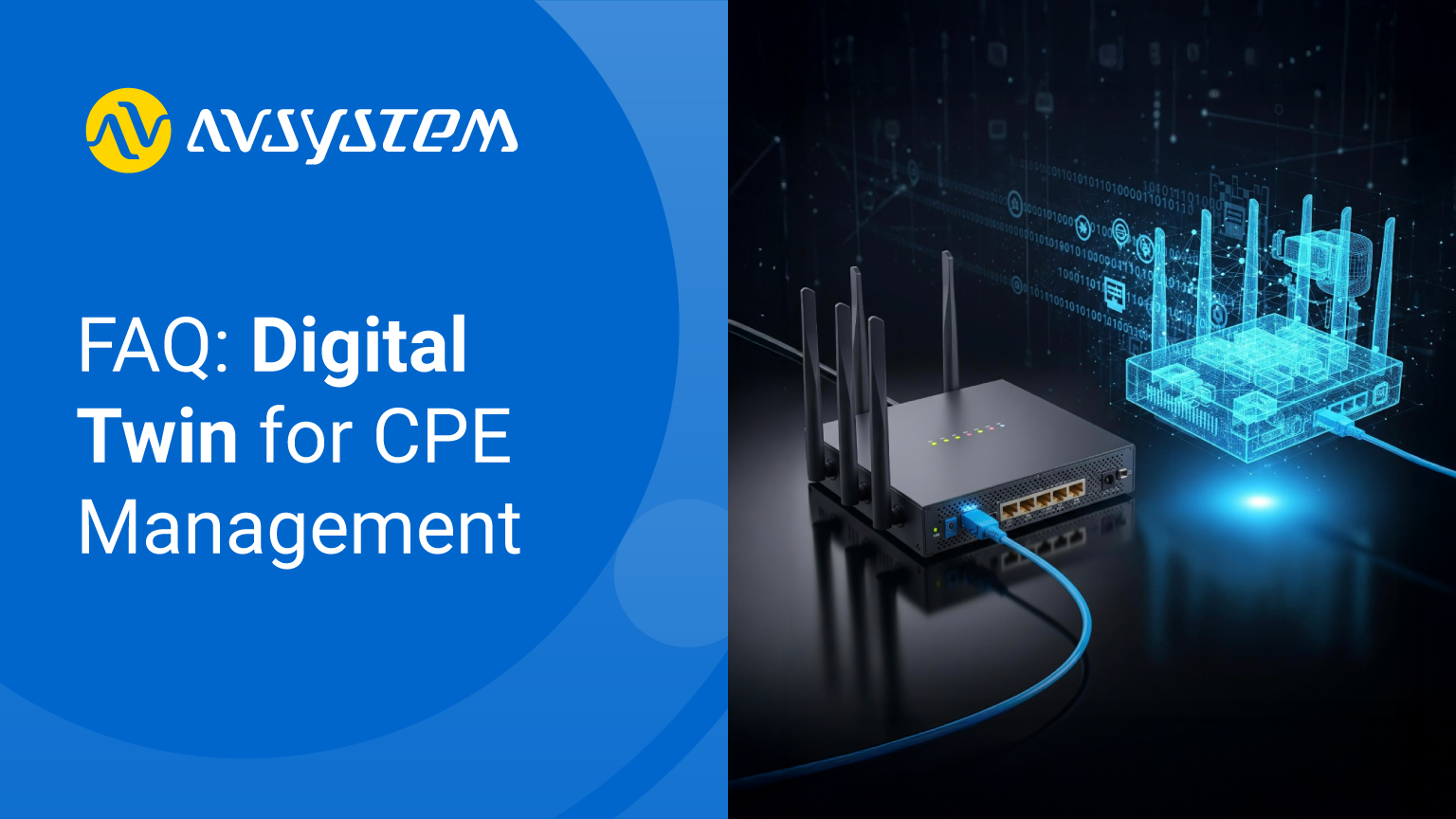Following our overview of Digital Twin for CPE over TR-069/TR-369, this FAQ answers the most common questions about how TR-069 and TR-369 (USP) enable digital twin functionality for broadband devices. It explains how digital twins work, what data they use, and why they are transforming the way ISPs and CSPs manage their networks and customer experience.
1. What is a digital twin in CPE management?
A digital twin is a virtual representation of a physical Customer Premises Equipment (CPE) device, such as a router, modem, or gateway, that continuously mirrors its state, configuration, and behavior within a management platform. It provides real-time or near-real-time visibility into device parameters, performance metrics, and operational status.
2. Why are digital twins important in broadband operations?
Digital twins allow service providers to move from reactive to proactive operations. Instead of manually polling devices, operators can monitor live data, predict failures, and make configuration changes safely. This leads to faster issue resolution, fewer truck rolls, and improved customer experience.
3. How does a digital twin differ from traditional device polling?
Traditional ACS systems rely on session-based communication: the device connects periodically, reports limited information, and disconnects. A digital twin, on the other hand, maintains a continuous, synchronized model of the device, updating automatically as parameters change. This eliminates data gaps and provides constant visibility.
4. How do TR-069 and TR-369 (USP) enable digital twins?
TR-069 (CWMP) enables centralized device management through periodic sessions, allowing configuration, firmware updates, and diagnostics.
TR-369 (USP) extends this model by maintaining a persistent, event-driven connection between the CPE and the management system, enabling real-time updates and continuous synchronization — the core of digital twin functionality.
See how digital twins over TR-069/TR-369 transform your CPE management.
5. Can TR-069 support digital twins, or is TR-369 required?
TR-069 can approximate digital twins by caching a device’s last-known state during each session. However, it cannot provide continuous telemetry or event-driven updates. TR-369 (USP) is required for true, real-time digital twins that update automatically and operate even when the device is temporarily offline.
6. What type of data is stored and synchronized in a CPE digital twin?
A digital twin holds configuration parameters, firmware version, performance counters, real-time telemetry, and logs of recent events. This information forms a complete, dynamic model of the CPE’s status and history, allowing operators to analyze behavior or test changes without directly accessing the device.
7. How does USP maintain real-time synchronization between the device and its twin?
USP uses persistent, event-driven communication via one of MTPs (Message Transfer Protocols): WebSockets, MQTT, or STOMP. Any change in the device — such as signal strength, interface load, or firmware state — triggers an immediate update to the management system. Conversely, configuration changes made to the twin are automatically pushed back to the CPE.
8. What role does the TR-181 data model play in digital twin functionality?
TR-181 defines the hierarchical data model for both TR-069 and TR-369, specifying how device parameters, telemetry objects, and services are represented. It operates independently from live data refresh and digital twin functions but ensures a consistent, standardized structure that enables any CPE to integrate seamlessly with the platform.
9. What are the main operational benefits of implementing digital twins?
Digital twins increase efficiency by enabling proactive maintenance, remote diagnostics, and automation at scale. They streamline operations by minimizing manual interventions and allow operators to validate firmware or configuration changes before deployment. The result is faster resolution and improved service reliability.
10. How do digital twins improve scalability and efficiency for large CPE fleets?
By managing synchronized twins instead of constantly polling physical devices or maintaining a persistent connection, ISPs can reduce network overhead and server load. USP’s event-driven model supports millions of concurrent devices, enabling large-scale operations without sacrificing performance or visibility.
11. How does digital twin technology support predictive maintenance and AI-driven insights?
Historical and real-time telemetry stored in digital twins provides a rich dataset for anomaly detection and predictive analytics. AI and machine learning models can use this data to forecast potential issues, optimize bandwidth allocation, and improve network planning and QoE (Quality of Experience).
12. How do AVSystem’s solutions implement hybrid TR-069 and TR-369 management?
AVSystem’s Cloud ACS and Unified Management Platform (UMP) integrate both TR-069 and TR-369 (USP) in a single system. This hybrid design allows operators to manage legacy and next-generation devices simultaneously, enabling a gradual, low-risk transition to USP-based digital twin operations.
13. What security mechanisms protect digital twin communications and data integrity?
Both TR-069 and TR-369 use secure transport protocols (HTTPS, TLS, DTLS, WebSockets over TLS) to protect communication. Authentication, encryption, and access control mechanisms ensure that only authorized entities can modify or view twin data, preventing unauthorized access and data leaks.
14. What challenges might ISPs face when adopting digital twin–based CPE management?
The main challenges include integrating legacy TR-069 systems with USP, ensuring consistent data modeling across vendors, and training operations teams. However, hybrid solutions like AVSystem’s TR-069 ACS/USP Controller simplify migration by offering compatibility with both standards.
15. How can ISPs start using digital twin technology in their operations today?
ISPs can begin by deploying a USP-capable ACS or Controller alongside their existing TR-069 platform. From there, they can onboard USP-enabled devices, create digital twins, and progressively migrate fleets. AVSystem provides both on-premises and SaaS deployments to support this transition.
Digital twins represent the next step in broadband service automation. They turn device management from reactive to predictive, delivering real-time insight, reduced operational costs, and higher customer satisfaction. With AVSystem’s Cloud ACS and USP Controller, ISPs can build a unified, standards-based ecosystem that brings true digital twin capability to every device they manage.
